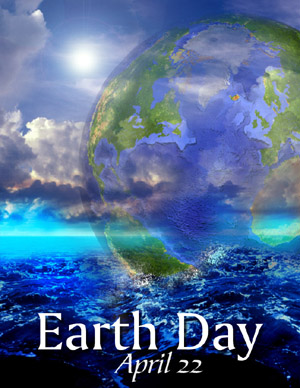
by Megan Sever Thursday, January 5, 2012

NOAA
On April 22, 1970, 20 million people across the United States celebrated the first Earth Day. “It was a time when cities were buried under their own smog and polluted rivers caught fire,” as the Environmental Protection Agency states on their Web site. Once again, Earth Day is celebrated this month, but now it’s a global phenomenon, with hundreds of millions of people participating in activities. What began as a grassroots effort to notice the environment has now grown into a global environmental movement.
Earth Day was founded by Gaylord Nelson, then a U.S. Senator from Wisconsin. Before he died in 2005, Nelson wrote the following:
“The idea for Earth Day evolved over a period of seven years starting in 1962. For several years, it had been troubling me that the state of our environment was simply a non-issue in the politics of the country. Finally, in November 1962, an idea occurred to me that was, I thought, a virtual cinch to put the environment into the political ’limelight’ once and for all.
The idea was to persuade President Kennedy to give visibility to this issue by going on a national conservation tour. I flew to Washington to discuss the proposal with Attorney General Robert Kennedy, who liked the idea. So did the President. The President began his five-day, eleven-state conservation tour in September 1963. For many reasons the tour did not succeed in putting the issue onto the national political agenda. However, it was the germ of the idea that ultimately flowered into Earth Day….
After President Kennedy’s tour, I still hoped for some idea that would thrust the environment into the political mainstream. Six years would pass before the idea that became Earth Day occurred to me while on a conservation speaking tour out West in the summer of 1969. At the time, anti-Vietnam War demonstrations, called ’teach-ins,’ had spread to college campuses all across the nation. Suddenly, the idea occurred to me — why not organize a huge grassroots protest over what was happening to our environment?...
Earth Day worked because of the spontaneous response at the grassroots level. We had neither the time nor resources to organize 20 million demonstrators and the thousands of schools and local communities that participated. That was the remarkable thing about Earth Day. It organized itself.”
By 1990, Earth Day became a global movement, involving 200 million people in 141 countries. By 2000, the Internet helped link activists around the world: 5,000 environmental groups participated, reaching out to hundreds of millions of people in 184 countries, according to Earth Day Network.
Earth Day celebrations initially focused on cleaning up the environment and recycling. In fact, the 1990 celebrations paved the way for the 1992 United Nations Earth Summit in Rio de Janeiro, Brazil, where the Framework Convention on Climate Change (which turned into the Kyoto Protocol) and the Convention on Biological Diversity, among other environmental initiatives, got their start.
Since 2000, activities have focused more on global climate change and pushes for clean energy. With the 40th anniversity of Earth Day approaching in 2010, the Earth Day Network is calling for a volunteer effort, dubbed "Generating a Billion Acts of Green." Earth Day 2009, meanwhile, marks the start of the Earth Day Network's Green Generation Campaign, which promotes renewable energy, sustainable consumption and the creation of green jobs.
On April 19, more than 100,000 people celebrated Earth Day at the National Mall in Washington, D.C. For Earth Day activities in your area or ways for you to reduce the energy you and your family use, visit the U.S. Government's Earth Day Web site, EPA's site or the Earth Day Network.
© 2008-2021. All rights reserved. Any copying, redistribution or retransmission of any of the contents of this service without the expressed written permission of the American Geosciences Institute is expressly prohibited. Click here for all copyright requests.